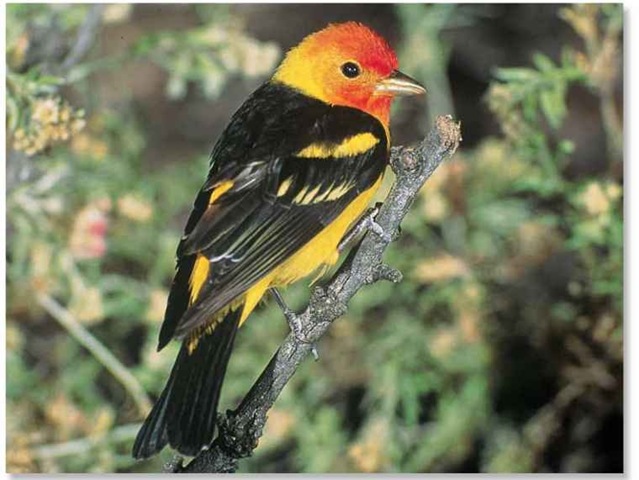ORDER
Passeriformes
FAMILY
Thraupidae
GENUS & SPECIES
key features
A bright, colorful bird; the male is more vivid, with a bold red head and facial feathers Catches flying insects in midair after scanning the forest canopy for prey Emits a song similar to that of a robin, but more hoarse and lower pitched
where in the world?
Found in North America from Alaska to California, from Texas to New Mexico; winters in Mexico, Central and south America
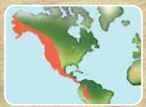
LIFECYCLE
Fluttering through its wooded habitat, the western tanager is an accomplished forager, deftly catching insects in midflight; it frequents a wide variety of forests.
HABITAT
The western tanager’s habitat varies according to season, but for the most part it inhabits open coniferous forests and mixed deciduous forests of mature aspen trees and alder groves. Beginning in April, populations arrive into the U.S. and Canada from as far south as South America. The western tanager seeks the cover of mature forests of Douglas fir, pine, spruce and aspen in mountains up to 10,000′. In the winter; when returning south to Mexico, Central and South America, the bird prefers pine and oak woodlands, low scrubby forest near coffee plantations and open areas with many scattered trees. During migration, small groups of about 30 tanagers roost in open habitats, such as parks and gardens.
Undercover agent A female tanager blends well with its forest habitat.
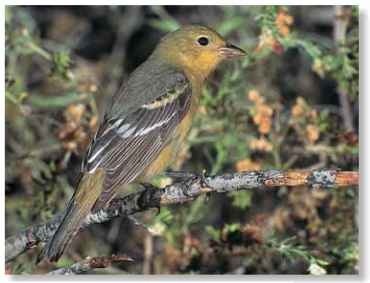
CONSERVATION
The western tanager is currently not threatened. Its widespread range, during both breeding and nonbreeding seasons, contributes to its success.All tanagers are protected by law and may not be kept in captivity without a permit.
BREEDING
Not much is known about the western tanager’s mating displays, other than that the male and female will fly together. The monogamous pairs stay together throughout the May-July breeding season.The female builds her nest on a horizontal tree branch, usually an oak or aspen, 10-65′ above ground.The cup nest is made of grasses, twigs and small pieces of bark, lined with hair and vegetation. The female lays 3-5 pale blue eggs with irregular brown spots. She incubates alone for 13 days, and is joined by the male when the nestlings hatch. Both parents feed the chicks wasps, bees (after removing the sting) and other insects and larvae. Fledging normally occurs in about 14-16 days.
HUNGRY BABIES
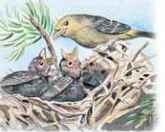
Begging…
A female tanager sits on the side of her nest preparing a meal for two hungry chicks, which are
eagerly begging for food.
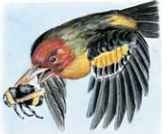
Helping father…
Both parents feed the chicks until they are ready to leave the nest.The male tanager captures a bee in its bill and will remove the sting.
FOOD & FEEDING
The western tanager forages in the forest canopy, taking to the air to search for insects such as flying ants and termites, as well as wasps and bees. Ants are another tanager favorite.The bird also eats nut weevils, wood borers, caterpillars, cicadas, termites and grasshoppers. The patient western tanager often remains motionless when it forages, only moving its head from side to side while scanning the air from its perch for flying prey.The bird also carefully searches through foliage or jumps on a collection of leaves, searching in a leisurely fashion for the food within.
The tanager’s diet is not limited to insects, though: it also plucks nectar from flowers or snatches dried fruit or sliced oranges from bird feeders. Lederberries, cherries, hawthorn apples and other fruits are seasonal favorites that help round out the tanager’s varied diet.
The early bird … The tanager’s stout bill makes easy prey out of worms and insects.
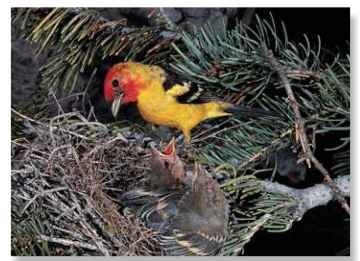
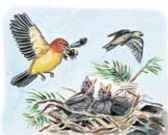
Mother too…
The male lands at the side of the nest, carrying the large bee in its bill, as the female flies off to search for more food for the chicks.
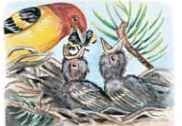
One to go
The male places the bee into the mouth of one of the chicks; the other must wait until the mother returns with more food.
BEHAVIOR
The solitary tanagers spend most of the day fluttering back and forth within the forest canopy foraging for food. The western tanager is not territorial, and it will not drive out intruders.The bird gathers with 30 or more tanagers during migrations; during the breeding season, tanagers live in pairs.This songbird’s call has been compared to that of a robin, but it is more hoarse with a lower pitch. In addition to its pit-ic call, the male western tanager produces an early-morning tu-weep. In flight, the western tanager maintains a steady path with rapid wing beats. Solitary but not shy, the tanager will take food from feeders and also bathe in birdbaths.
Time out
The solitary tanager enjoys a quiet moment.
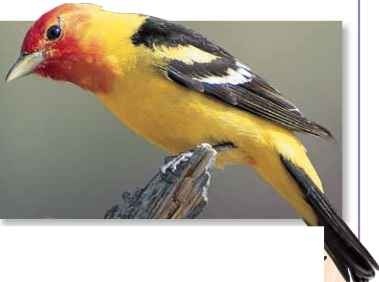
A tanager was once observed flying 30′ straight up into the air before diving in a direct line back to its perch.
“The Western Tanager” is the title of the Los Angeles Audubon Society newsletter.
The western tanager was first named the Louisiana tanager, since Lewis and Clark first discovered it in the western portion of the Louisiana Territory.
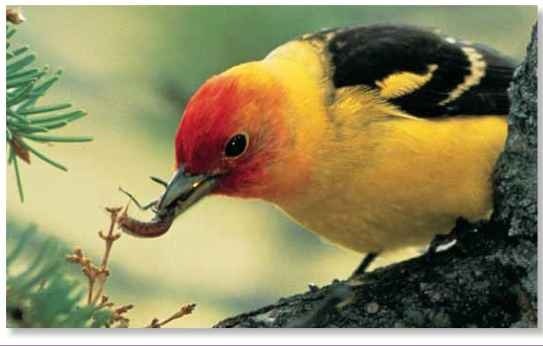
Profile
Western Tanager
The multicolored western tanager glows in sunlight when catching insects in flight and contrasts with forest foliage when pecking at berries.
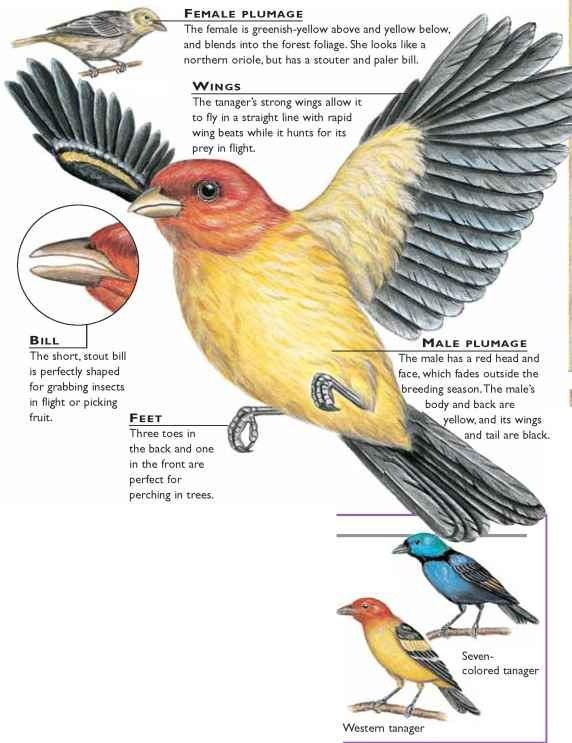
CREATURE COMPARISONS
Slightly smaller than the western tanager, the seven-colored tanager (Tanager fastuosa) measures up to 5″ in length. It is found in the forests of northeastern Brazil in the highest branches of large trees, from lowlands to heights of 2,700′. Unlike the solitary western tanager, the seven-colored tanager associates with a variety of other birds.The South American bird is named for its plumage, a mixture of blue, green, purple, yellow, orange, black and cyan (a blue-green mix). Its song is a repetitive it-it-it-it Considered a prize ornamental cage bird, seven-colored tanager populations are threatened.
| vital statistics | |
| Weight | 0.8-1.3 oz. |
| Length | 6.25-7.5″ |
| Wingspan | 11-12″ |
| Sexual Maturity | About 1 year |
| Breeding’ ‘ -Season | May-July |
| Number of Eggs | 3-5 |
| Incubation Period | 13 days |
| Fledging ‘ Period | About 14-16 days |
| Breeding Interval | 1 year |
| Typical Diet | B Bees, wasps, insects, fruits and berries |
| Lifespan | Over 15 years in captivity |
Related species
• The western tanager is I of 9 species in the genus Piranga, which also includes the hepatic tanager, R flava, scarlet tanager, R olivacea and the summer tanager, R rubra. The family Traupidae is limited to the Western Hemisphere, but only 6 of the 236 species inhabit North America. The blue-gray tanager, Thraupis virens, became established in Florida after escaping from captivity.
